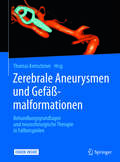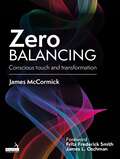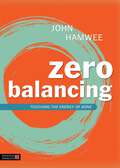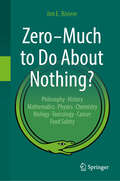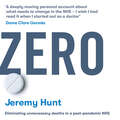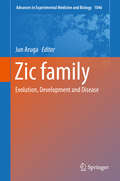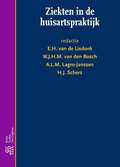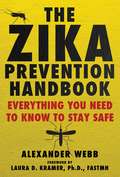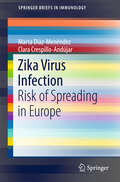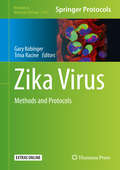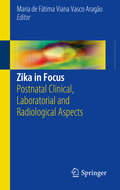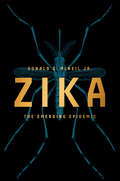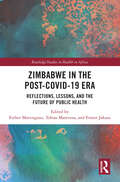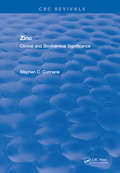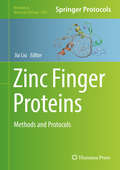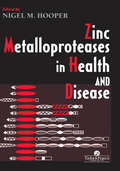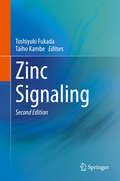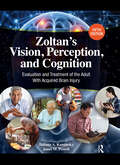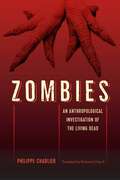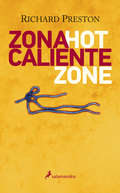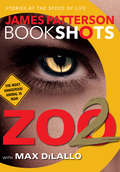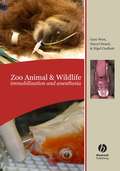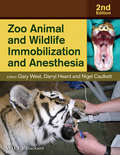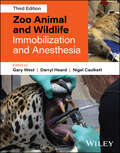- Table View
- List View
Zerebrale Aneurysmen und Gefäßmalformationen: Behandlungsgrundlagen und neurochirurgische Therapie in Fallbeispielen
by Thomas KretschmerEindrucksvolle Fallbeispiele zur individuellen Therapiewahl und Therapiedurchführung.<P><P> Empfehlungen zum operativen Vorgehen und Hinweise auf Gefahren und Risiken.<P> Ausführliche Kapitel zu anatomischen Varianten und zur spezifischen Pathoanatomie.<P> Anhand von 28 ausführlichen Fallbeispielen stellt dieses Buch das operative Vorgehen bei intrakraniellen Aneurysmen und Malformationen dar. Dabei wird ein breites Spektrum von Krankheitsformen, Lokalisationen und Eingriffen gezeigt. Zu jedem Fall werden die klinische Situation, die individuelle Anatomie und die Datenlage beschrieben; das therapeutische Vorgehen wird begründet und umfassend in Wort und zahlreichen Abbildungen geschildert, auch auf Risiken und mögliche Komplikationen gehen die Kapitel ein. Abgeschlossen wird jedes Fallbeispiel durch eine Analyse des gewählten Procedere und daraus abgeleiteten Empfehlungen für vergleichbare Konstellationen. Ausgewählte Falldarstellungen werden durch Videos ergänzt. Allgemeine Informationen zur anatomischen Variabilität zerebraler Gefäße, zu den chirurgischen und strahlentherapeutischen Behandlungsprinzipien, zur Pathologie und Klassifikation der einzelnen Erkrankungsgruppen sowie zur intraoperativen Diagnostik runden die Darstellung ab.
Zero Balancing: Conscious touch and transformation
by Jim McCormickZero Balancing - conscious touch and transformation offers a practical and multi-layered approach to personal transformation for practitioners of Zero Balancing. The author explains the basic principles of Zero Balancing and then gives examples of how to use those principles in bodywork through the use of fascinating case histories and detailed stories of individual sessions with clients. Overall the book provides a step-by-step guide for clinicians. Each chapter stands on its own but together they build up to give the whole story of Zero Balancing's unique ability to assist in personal transformation for ZB clients. The book illustrates how working with the body and mind through touch can lead to a richer sense of self and a more satisfying life as well as assisting with numerous health issues.Jim McCormick is known for creating a caring and creative environment, where participants feel safe to be their full selves, while exploring new ideas and skills. Into the pages of this book he has woven his 50 years of experience in alternative medicine. His explanation of the unique principles behind Zero Balancing and how to apply them is presented clearly, warmly and with good humor and joy.
Zero Balancing: Touching the Energy of Bone
by John Hamwee Fritz Smith Gina MichaelsThe definitive guide to Zero Balancing brings this increasingly popular therapy to life. It contains a clear description of the anatomy and physiology of energy which leads on to a compelling explanation of how and why this form of bodywork can have such powerful effects. Throughout, there are illustrations which convey the unique energy of a Zero Balancing session and John Hamwee provides fascinating examples of clients, their experiences and the outcomes of the work.
Zero – Much to Do About Nothing?
by Jim E. RiviereZero – Much to Do About Nothing? is a thought-provoking work that delves into the complexities of defining “zero” in various fields, from mathematics and physics to pharmacology and food safety. Drawing on his extensive experience in teaching, research and managing a USDA-supported chemical food safety program, Jim E. Riviere provides readers with practical examples and case studies that highlight the challenges of defining “zero” in different contexts across a wide range of fields. In his four decades of university teaching, doing research in pharmacology, toxicology, biomathematics and nanoscience, Dr. Riviere has repeatedly encountered the concept of “zero” and the broad parameters utilized to achieve a proper definition. "Zero” enters when discussions concern defining "nothing", "negligible", "very small", "below level of detection", "absence of effect" or "safe". This renders the term “zero” incredibly confusing to scientists, practitioners and regulators. This book explores the origin of the concept of “zero” in mathematics, physics, chemistry and statistics and how these concepts migrated to fields such as pharmacology, toxicology, cancer research and food safety, as well as to the legal profession in the form of regulatory science and policy. Specific chapters deal with the application of “zero” to these distinct fields. The main focus throughout the book is to illustrate how important context is to the definition of “zero”. This has assumed greater relevance today with the advent of nanoscience where “small” implies different physical and chemical behavior and the use of artificial Intelligence to analyze vast troves of data from the web. The goal of the book is to provide much-needed clarity about "zero" and break down the many issues preventing it. Riviere expertly explains how the concept of “zero” is essential to a wide range of issues, from defining negligible amounts of a substance to determining the safety of a product or process. He shows how the term “zero” can have different meanings in different fields and how this can lead to confusion and misunderstandings among scientists, practitioners and regulators. Whether you're working in Food Safety, Chemistry, Pharmacology, Mathematics, Physics or beyond, Zero – Much to Do About Nothing? is a relatable book that will deepen your understanding of the concept of “zero” and its diverse applications.
Zero: Eliminating unnecessary deaths in a post-pandemic NHS
by Jeremy HuntHow many avoidable deaths are there in the NHS every week?150.What figure should we aim for?Zero.The NHS is the pride of Britain. It's an army of highly skilled and talented healthcare professionals, armed with the most cutting-edge therapies and medicines, and a budget bigger than the GDP of most countries in the world.Yet avoidable failures are common. And the result is tragic deaths up and down the country every day.Jeremy Hunt, the longest-serving Health Secretary in history, knows exactly what the cost is. In the letters he received from bereaved family members, he was constantly confronted by the heart-breaking reality of slip-ups and mistakes.There is increasing conflict between public pride in the NHS and the exhausted daily reality for many doctors and nurses, now experiencing burnout in record numbers. Waiting lists are up, staffing numbers inadequate, and all the while an ageing population and medical advances increase both demand and expectations. With pressures like these, is it surprising that mistakes start to creep in?This great British institution is crying out for renewal. In Zero, taking the broadest approach, thinking through everything from staffing to technology, budgets to culture, Hunt presents a manifesto for that renewal.Mistakes happen. But nobody deserves to become a statistic in an NHS hospital. That's why we need to aim for zero.
Zic family: Evolution, Development and Disease (Advances in Experimental Medicine and Biology #1046)
by Jun ArugaIs the first comprehensive review of the Zic family-related studies in biology and medicine.<P><p> Presents the Zic genes for the nervous system appearance is utilized in the animal evolution.<P> Provides the cutting edge information for common genetic disorders, stem cell and cancer cell biology .<P> This book provides a comprehensive overview of ZIC-family research. <P>Part 1 summarizes the ZIC family in animal evolution and development and presents an overall picture of the ZIC family gene structure in eumetazoan animals, providing an evolutionary hypothesis and reviewing the studies on the role of ZIC family proteins in developmental processes for each animal model. Part 2 shows that the ZIC family are the causative genes for developmental disorders, and discusses the role of the ZIC family in stem cell biology. It also presents studies on the ZIC family in the medical biology field. This interdisciplinary book is a valuable resource not only for those people directly involved in ZIC-family-related research, but also researchers in diverse research fields who are interested in the latest advances in biology and medicine.
Ziekten in de huisartspraktijk (5e druk)
by W.J.H.M. van den Bosch E.H. van de Lisdonk A.L.M. Lagro-Janssen H. J. SchersIn 1971 werd de eerste continue morbiditeitregistratie in Nederland gestart, de CMR-Nijmegen. Sindsdien leggen de huisartsen uit de vier deelnemende praktijken alle gezondheidsstoornissen vast die de patiënten uit deze praktijken doormaken en die bij hen zijn vastgesteld door de eigen huisarts, waarnemend huisartsen, praktijkassistenten en medisch specialisten. Uitgaande van dit inmiddels zeer grote en rijke databestand beschrijven de CMRartsen in dit boek meer dan 150 ziekten en aandoeningen. Zij bespreken klinisch beeld, beloop, prognose en behandeling in relatie tot de epidemiologische kenmerken van deze ziekten en aandoeningen. Centraal staan de veranderingen in de frequentie van vóórkomen in de loop van de registratieperiode en de incidentie- en prevalentiecijfers naar leeftijd en geslacht. Deze worden, waar relevant, aangevuld met gegevens over het vóórkomen naar jaargetijde en sociaal-economische klasse. De definitieve teksten in dit boek zijn totstandgekomen in een intensief proces van discussie en bijstelling, waardoor er een aanzienlijke hoeveelheid huisartservaring in is verwerkt. In deze vijfde druk van Ziekten in de huisartspraktijk zijn de registratiegegevens van 1985 tot en met 2006 opgenomen en de nieuwste inzichten verwerkt. Bovendien zijn de teksten aangescherpt en gestroomlijnd met de inhoud van de NHGstandaarden. De redacteuren en auteurs zijn allen huisarts, voor het merendeel verbonden aan de Afdeling Huisartsgeneeskunde van het UMC St Radboud te Nijmegen.
Zika Prevention Handbook: Everything You Need To Know To Stay Safe
by Alexander Webb Laura KramerAs the Zika virus continues to spread throughout North America, people need answers. What are the origins of this virus? How does it spread? Should we be concerned? How can we stop the spread of infected mosquitos? With the increasing prevalence of Zika, concrete answers are needed now more than ever - The Zika Prevention Handbook serves as the best reference for readers to stay informed about side-effects and symptoms, and to minimize your chance of contracting the virus. The Zika virus is a mosquito-borne infection that is estimated to have originated in Africa in the mid 1940's. In the last several years, the Zika virus has infected thousands of people around the world and has spread to over 60 countries. As of August 2016, Zika-infected mosquitoes have found a new home, the United States. The Zika virus has been reported in all 50 U. S. states, in addition to hundreds of reported cases throughout Mexico and Canada. With the assistance of infectious disease expert, Laura D. Kramer, PhD, author Alexander Webb has compiled the leading research from the U. S. Centers for Disease Control and Prevention (CDC). Whether you're an expectant mother worried about microcephaly (a side effect of Zika that causes babies to be born with abnormally small heads), planning a vacation to a tropical area, or living in an area where these contagious mosquitoes reside, this book is guaranteed to answer all your questions and ease your fears. Readers will learn about Zika's origins, transmission of the infection, leading prevention techniques, medical testing, symptoms and diagnosis, and much more. Do yourself a favor and arm yourself with the life-saving knowledge contained in The Zika Prevention Handbook
Zika Virus Infection: Risk of Spreading in Europe (SpringerBriefs in Immunology)
by Marta Díaz-Menéndez Clara Crespillo-AndújarThis book describes the demographic and clinical patterns of Zika infection and evaluates the risk of it spreading to Europe. It reflects the hands-on experience of the author, who as a physician, was faced with the first-ever cases reported in Europe. Providing essential background information on the viral vector, it addresses the various symptoms after infection, and places them in the epidemiological context of past outbreaks.
Zika Virus: Methods and Protocols (Methods in Molecular Biology #2142)
by Gary Kobinger Trina RacineThis volume discusses the latest protocols used by scientists to understand ZIKV and how to mitigate its presence. These studies will benefit in the detection, diagnosis, management, treatment, and prevention of this infection. The chapters in this book cover techniques in virus isolation, purification, and ways to titrate the virus; recent advancements made in the development of modified molecular techniques; and a discussion on Zika virus itself to help readers better understand this pathogen. Written in the highly successful Methods in Molecular Biology series format, chapters include introductions to their respective topics, lists of the necessary materials and reagents, step-by-step, readily reproducible laboratory protocols, and tips on troubleshooting and avoiding known pitfalls.Cutting-edge and practical, Zika Virus: Methods and Protocols is a valuable resource for both novice and expert scientists interested in learning more about this important topic.
Zika in Focus: Postnatal Clinical, Laboratorial and Radiological Aspects
by Maria de Fátima Viana Vasco AragãoThis book addresses the most important postnatal features of Zika virus infection, providing important information on its epidemiology, pathology, clinical aspects, imaging and laboratory diagnosis. Since the report of a Zika virus infection epidemic in Northeastern Brazil in 2015, the world has paid close attention to this emergent disease. Historically, this has been the third outbreak of Zika infection described (preceded by outbreaks in Micronesia and French Polynesia), but for the first time the association with congenital microcephaly and other neurological co-morbidities in infants from women infected with the Zika virus was observed. Since then, government bodies, public health agencies, medical societies and scholars have joined forces to understand this disease, and to promote its prevention and management. <P><P>Currently, the relationship between Zika virus and microcephaly is well established, as well as the most characteristic findings of congenital Zika syndrome (e.g. microcephaly, arthrogryposis, ophthalmologic and hearing abnormalities). Also, the spectrum of the disease’s severity has broadened, with less severe cases (without microcephaly) being recently recognized. Even so, there is currently a dearth of material on Zika virus infection for healthcare professional around the world. <P>Addressing that gap, Zika In Focus – Postnatal Aspects aims to help the medical community worldwide by presenting the most important features of Zika virus infection from a postnatal perspective. It is intended to all professionals and researchers interested in this condition, especially paediatricians, radiologists and neurologists, offering them a practical guide to recognizing congenital Zika syndrome in its many aspects and focusing on the radiological pattern of lesions that can be found from the mild to the most severe cases.
Zika: The Emerging Epidemic
by Donald G. Mcneil Jr.A gripping narrative about the origins and spread of the Zika virus by New York Times science reporter Donald G. McNeil Jr. Until recently, Zika--once considered a mild disease--was hardly a cause for global panic. But as early as August 2015, doctors in northeast Brazil began to notice a trend: many mothers who had recently experienced symptoms of the Zika virus were giving birth to babies with microcephaly, a serious disorder characterized by unusually small heads and brain damage. By early 2016, Zika was making headlines as evidence mounted--and eventually confirmed--that microcephaly is caused by the virus, which can be contracted through mosquito bites or sexually transmitted. The first death on American soil, in February 2016, was confirmed in Puerto Rico in April. The first case of microcephaly in Puerto Rico was confirmed on May 13, 2016. The virus has been known to be transmitted by the Aedes aegypti or Yellow Fever mosquito, but now Aedes albopictus, the Asian Tiger mosquito, has been found to carry it as well, which means it might affect regions as far north as New England and the Great Lakes. Right now, at least 298 million people in the Americas live in areas "conducive to Zika transmission," according to a recent study. Over the next year, more than 5 million babies will be born. In Zika: The Emerging Epidemic, Donald G. McNeil Jr. sets the facts straight in a fascinating exploration of Zika's origins, how it's spreading, the race for a cure, and what we can do to protect ourselves now.
Zimbabwe in the Post-COVID-19 Era: Reflections, Lessons, and the Future of Public Health (Routledge Studies in Health in Africa)
by Esther Mavengano, Tobias Marevesa, and Ernest JakazaThis comprehensive book brings together reflections, lessons and insights relating to the post Covid-19 era in Zimbabwe. The outbreak of the COVID-19 pandemic has immensely affected all facets of humanity globally. Its impact on Zimbabwe is evident through its effect on socio-economic and education systems, politics, religion, infrastructural development, and health delivery systems. This book provides scholarly introspections into the lessons drawn from the pandemic in an effort to re-imagine the future possibilities of public health in Zimbabwe and beyond. Providing a platform for research that seeks to re-think global public health matters from a Decolonial school of thought, the book asks questions such as: What is the role of religion, linguistics, communication, education, economics, politics, and science in preparing Zimbabwe for possible future pandemics? How can the lessons drawn from the pandemic inform scholars to re-imagine the future trajectories of the country in the various domains? How can researchers evaluate the power and economic dialectics of COVID-19, navigate the tumultuous challenges generated, and come up with appropriate systems for future pandemics? Offering a realistic picture of the post COVID-19 era in Zimbabwe, the book will be a key resource to students and researchers across the fields of political communication, science communication, decolonial discourse, language and culture, as well as African Studies more broadly.
Zinc Clinical and Biochemical Significance
by Stephen C. CunnaneIn keeping with the etiology theme, it also became apparent that the clinical aspects needed to be strictly separated from the animal aspects of zinc metabolism, a separation that has never previously been attempted. Although this division, like the separation of primary from secondary zinc depletion, may be somewhat arbitrary, it is the author‘s impression that current knowledge of the truly clinical aspects of zinc metabolism is too often confused with its effects in animals. The two will frequently be similar, but not always. In this book, therefore, animal studies are considered in part 2 (Biochemistry. Only a handful of references to animal studies has been included in part 1 (Clinical). The purpose of this separation is to clearly distinguish animal from human, experimental from clinical. Too many of the animal studies have involved severe and prolonged zinc deficiency or other exaggerated nutritional conditions that cannot be realistically applied in the clinical setting. Furthermore, animal studies are mainly or primary (dietary) zinc depletion, whereas in humans, secondary zinc depletion is more prevalent and has a more diverse etiology.
Zinc Finger Proteins: Methods and Protocols (Methods in Molecular Biology #1867)
by Jia LiuThis detailed volume explores the notable progress in the field of zinc finger proteins (ZFP) study through widely used methods and protocols involving their biological functions and applications. Beginning with a section on the basic biology of ZFPs and design and applications of custom ZFPs, the book continues by covering methods for the evaluation and prevention of ZFN-mediated cytotoxicity as well as a collection of the representative methods of ZFN delivery. Written for the highly successful Methods in Molecular Biology series, chapters include introductions to their respective topics, lists of the necessary materials and reagents, step-by-step, readily reproducible laboratory protocols, and tips on troubleshooting and avoiding known pitfalls. Authoritative and practical, Zinc Finger Proteins: Methods and Protocols aims to prompt both the understanding of ZFP biology and the development of next-generation ZFP therapeutics.
Zinc Metalloproteases In Health And Disease
by Nigel M. HooperThe zinc metalloproteases are a diverse group of enzymes which are becoming increasingly important in a variety of biological systems. Their major function is to break down proteins. This text presents recent research results on the biochemistry and molecular biology of these enzymes.
Zinc Signaling
by Toshiyuki Fukada Taiho KambeThis book, now in an extensively revised second edition, describes the crucial role of zinc signaling in biological processes on a molecular and physiological basis. Global leaders in the field review the latest knowledge, including the very significant advances in understanding that have been achieved since publication of the first edition. Detailed information is provided on all the essentials of zinc signaling, covering molecular aspects and the roles of zinc transporters, the zinc sensing receptor, and metallothioneins. Detection techniques for zinc signals, involving genetically encoded and chemical probes, are also described. The critical contributions of the zinc signal in maintaining health and the adverse consequences of any imbalance in the signal are then thoroughly addressed. Here, readers will find up-to-date information on the significance of the zinc signal in a wide range of conditions, including cardiovascular disorders, neurodegenerative diseases, diabetes, autoimmune diseases, inflammatory conditions, skin disease, osteoarthritis, and cancer. The book will be of value for researchers, clinicians, and advanced students.
Zo werkt het in de apotheek (Basiswerk AG)
by J.R. Mentink C.R.C. Huizinga-ArpDit boek biedt de noodzakelijke basis voor apothekersassistenten in opleiding om in de beroepspraktijkvorming een beeld te krijgen van bepaalde werkwijzen in de apotheek. Ze krijgen antwoorden op vragen als: Hoe verloopt een dag in de apotheek? Welke producten en diensten levert een apotheek? Wie werken er? Hoe wordt het werk georganiseerd? Aan welke regels moet worden voldaan en welke kwaliteitseisen worden gesteld? Hoe wordt alles betaald? Zo werkt het in de apotheek heeft raakvlakken met alle kerntaken uit het Kwalificatiedossier mbo Apothekersassistent: geïndividualiseerde farmaceutische patiëntenzorg (kerntaak 1), niet-receptgestuurde zorg aan de patiënt (kerntaak 2), productzorg (kerntaak 3) en werken aan kwaliteit en deskundigheid (kerntaak 4). Een goedlopende apotheek heeft al deze elementen samen weten te brengen in een organisatie die bovendien op de juiste manier weet in te spelen op de alsmaar veranderende omgeving. Hoewel de openbare apotheek centraal staat, worden ook andere soorten apotheken besproken en is aandacht voor andere zorgverleners waarmee de apotheek samenwerkt. Daarnaast wordt stilgestaan bij de kosten van de gezondheidszorg. Hierbij komt de steeds belangrijker wordende rol van de zorgverzekeraar aan bod, zoals de invloed van contractafspraken tussen apothekers en zorgverzekeraars op het werk van apothekersassistenten. In het boek is verder aandacht voor de wet- en regelgeving waarmee de apothekersassistenten in aanraking komen en die de dagelijkse werkzaamheden beïnvloedt.Deze nieuwe editie is geactualiseerd en aangepast aan nieuwe wet- en regelgeving, zoals de AVG. Het boek is een onmisbaar naslagwerk voor apothekersassistenten (in opleiding). Jeroen Mentink (1977) studeerde farmacie in Utrecht en behaalde daar in 2003 het apothekersdiploma. Hij is werkzaam als openbaar apotheker in Zierikzee. Naast zijn werkzaamheden als apotheker is hij actief in diverse commissies, docent voor na- en bijscholingen op mbo, hbo en universitair niveau en betrokken bij de ontwikkeling van vakinhoudelijke nascholingen voor diverse doelgroepen.Carolijn Huizinga-Arp (1967) studeerde farmacie in Utrecht en behaalde daar in 1992 het apothekersdiploma. Zij is werkzaam als openbaar apotheker, actief in verschillende bestuurlijke functies en vanuit haar eigen schrijfbureau betrokken bij de ontwikkeling van cursussen voor apothekersassistenten, doktersassistenten, huisartsen en apothekers.
Zoltan’s Vision, Perception, and Cognition: Evaluation and Treatment of the Adult with Acquired Brain Injury
by Tatiana Kaminsky Janet PowellThe go-to guide for nearly 50 years for occupational therapists working with adults with visual, perceptual, and cognitive deficits after brain injury is back for a Fifth Edition.Zoltan’s Vision, Perception, and Cognition: Evaluation and Treatment of the Adult With Acquired Brain Injury, Fifth Edition maintains the core foundation laid in previous editions while drawing upon Drs. Tatiana A. Kaminsky and Janet M. Powell’s 60-plus years combined of clinical, teaching, and research experience in adult neuro-based rehabilitation.This best-selling text translates the available research and theory into application for practice. The result is a comprehensive, accessible, up-to-date, and evidence-informed textbook with a strong occupation-based focus, detailing occupational therapy evaluation and treatment practices for adults with visual, perceptual, and cognitive deficits after brain injury.What’s new in the Fifth Edition: An emphasis on functional cognition, occupational focus, and changes in approaches to rehabilitation Clinical examples from adult neurorehabilitation to ease understanding Up-to-date evidence and everyday technology implementation Tips for collaborating with a team of practitioners New case examples Included with the text are online supplemental materials for faculty use in the classroom.Zoltan’s Vision, Perception, and Cognition: Evaluation and Treatment of the Adult With Acquired Brain Injury, Fifth Edition includes key updates to stay current while maintaining the essence of its previous editions.
Zombies: An Anthropological Investigation of the Living Dead
by Philippe Charlier“A compelling account of the zombi as an anthropological reality and evocative symbol of a state of dispossession, desperation, and death.”—Roger Luckhurst, author of Zombies: A Cultural History “An adventurer’s anthropological quest offering a novel description of the contemporary zombie.”—Sarah J. Lauro, author of The Transatlantic Zombie: Slavery, Rebellion, and Living Death “Displays an empathy for the cultural reality of the zombie in Haiti that delivers important insight on the island nation’s people and their lived realities.”—Christopher M. Moreman, coeditor of Race, Oppression and the Zombie: Essays on Cross-Cultural Appropriations of the Caribbean Tradition Forensic pathologist Philippe Charlier—dubbed the “Indiana Jones of the graveyards”—travels to Haiti where rumors claim that some who die may return to life as zombies. Charlier investigates these far-fetched stories and finds that, in Haiti, the dead are a part of daily life. Families, fearing that loved ones may return from the grave, urge pallbearers to take rambling routes to prevent the recently departed from finding their way home from cemeteries. Corpses are sometimes killed a second time…just to be safe. And a person might spend their life preparing their funeral and grave to ensure they will not become a wandering soul after death. But are the stories true? Charlier’s investigations lead him to Vodou leader Max Beauvoir and other priests, who reveal how bodies can be reanimated. In some cases, sorcerers lure the dead from their graves and give them a potion concocted from Devil’s Snare, a plant more commonly known as Jimsonweed. Sometimes secret societies use poudre zombi—“zombie powder”—spiked with the tetrodotoxin found in blowfish. Charlier eagerly collects evidence, examining Vodou dolls by X-ray, making sacrifices at rituals, and visiting cemeteries under the cloak of night. Zombies follows Charlier’s journey to understand the fascinating and frightening world of Haiti’s living dead, inviting readers to believe the unbelievable.
Zona caliente
by Richard PrestonLa historia del brote de Ébola más mortífero en la historia: un relato apasionante de los médicos y científicos que lucharon, y luchan, por protegernos. Zona caliente: área del laboratorio denominada así por los científicos que investigan los virus más letales como el ébola. Sellada herméticamente, sus accesos están rigurosamente controlados y los operarios visten trajes especiales sometidos a duchas de desinfección antes de abandonar el recinto. Parte de los hechos narrados en este libro transcurren en una «zona caliente» gestionada por el Ejército de Estados Unidos en Maryland. Zona caliente fue escrito y publicado en 1994 para explicar los orígenes y la evolución del virus ébola y advertir del peligro de su propagación en el futuro. Su autor, Richard Preston, catedrático de la Universidad de Princeton y un destacado especialista en abordar temas científicos con un alto nivel de rigor y conocimiento de la materia -ha sido galardonado con el Premio del Instituto de Física de Estados Unidos y Zona caliente es lectura recomendada en los institutos de Norteamérica-, fue el primero en dar a conocer al gran público la amenaza del ébola, un virus potencialmente mil veces más letal que el VIH del sida y que, hasta el día de hoy, no ha sido controlado en su totalidad. La narración de esta historia, que se lee como una novela, se basa en hechos reales documentados con precisión y contrastados hasta el límite de lo posible. El resultado es un relato apasionante y esclarecedor, una fuente rica en datos fidedignos sobre todos los aspectos involucrados en este desafío de la naturaleza. Así, los lectores podrán formarse una opinión razonada por encima de todo el torrente de informaciones fragmentadas que propician en la opinión pública una sensación de desconcierto y temor.
Zoo 2 (BookShots)
by James Patterson Max Dilallo<P>Will the last humans on Earth please turn out the lights? <P>James Patterson's ZOO was just the beginning. The planet is still under violent siege by ferocious animals. Humans are their desperate prey. Except some humans are evolving, mutating into a savage species that could save civilization-or end it. <P><b>A New York Times Bestseller</b>
Zoo Animal and Wildlife Immobilization and Anesthesia
by Darryl Heard Gary West Nigel CaulkettZoo Animal and Wildlife Immobilization and Anesthesia is the definitive, comprehensive reference for the growing fields of zoo, wildlife, and exotic animal veterinary medicine. <P><P>This book covers key aspects of immobilization and anesthesia from pharmacology and restraint to supportive care. Alongside these chapters, the editors have brought together an impressive collection of species-specific chapters that will be an invaluable resource to those called upon to treat these animals.
Zoo Animal and Wildlife Immobilization and Anesthesia
by Darryl Heard Gary West Nigel CaulkettZoo Animal and Wildlife Immobilization and Anesthesia, Second Edition is a fully updated and revised version of the first comprehensive reference on anesthetic techniques in captive and free-ranging wildlife. Now including expanded coverage of avian and aquatic species, this exhaustive resource presents information on the full range of zoo and wildlife species. Covering topics ranging from monitoring and field anesthesia to CPR and euthanasia, the heart of the book is devoted to 53 species-specific chapters providing a wealth of information on little-known and common zoo and wildlife animals alike. In addition to new species chapters, the new edition brings a new focus on pain management, including chronic pain, and more information on species-specific physiology. Chapters on airway management, monitoring, emergency therapeutics, and field procedures are all significantly expanded as well. This update to Zoo Animal and Wildlife Immobilization and Anesthesia is an invaluable addition to the library of all zoo and wildlife veterinarians.
Zoo Animal and Wildlife Immobilization and Anesthesia
by Darryl Heard Gary West Nigel CaulkettA new and updated edition of the classic reference to animal and wildlife anesthesia Zoo Animal and Wildlife Immobilization and Anesthesia, Third Edition offers a thoroughly updated edition of this comprehensive reference to anesthetic techniques in captive and free-ranging wild species. Featuring 57 species-specific chapters covering animals both common and uncommon, the book includes both the basic principles of capturing, anesthetizing, and monitoring these animals and species-specific considerations. All chapters have been thoroughly updated to reflect new information and references. The definitive reference for delivering anesthesia to zoo and wild animals, the book presents the gold standard for all aspects of anesthesia in a variety of settings. This Third Edition: Offers a fully updated new edition of the gold-standard reference to immobilization and anesthesia in captive and free-ranging wildlife Presents 57 species-specific chapters covering all aspects of anesthetizing zoo and wild animals, ranging from commonly treated animals to rare species Focuses on providing exceptional health care to wild and zoo animals Fully updated throughout to present new information, advances, and references Features full color photographs to demonstrate the concepts discussed Zoo Animal and Wildlife Immobilization and Anesthesia is an essential guide for zoo and wildlife practitioners, veterinary professionals, and veterinary students, as well as wildlife or conservation biologists.
